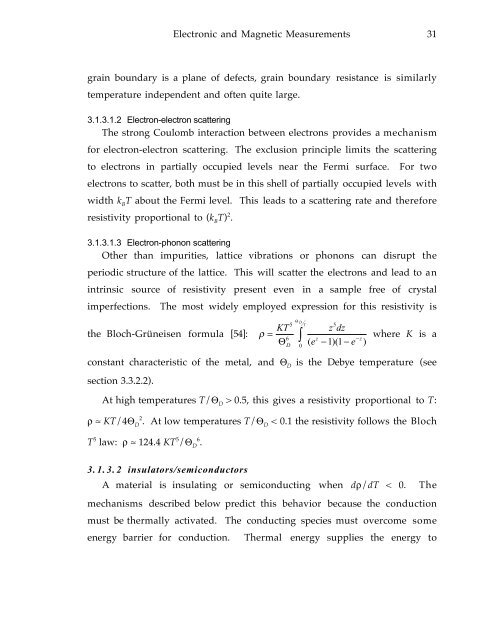MAGNETISM ELECTRON TRANSPORT MAGNETORESISTIVE LANTHANUM CALCIUM MANGANITE
MAGNETISM ELECTRON TRANSPORT MAGNETORESISTIVE LANTHANUM CALCIUM MANGANITE
MAGNETISM ELECTRON TRANSPORT MAGNETORESISTIVE LANTHANUM CALCIUM MANGANITE
Create successful ePaper yourself
Turn your PDF publications into a flip-book with our unique Google optimized e-Paper software.
Electronic and Magnetic Measurements 31<br />
grain boundary is a plane of defects, grain boundary resistance is similarly<br />
temperature independent and often quite large.<br />
3.1.3.1.2 Electron-electron scattering<br />
The strong Coulomb interaction between electrons provides a mechanism<br />
for electron-electron scattering. The exclusion principle limits the scattering<br />
to electrons in partially occupied levels near the Fermi surface. For two<br />
electrons to scatter, both must be in this shell of partially occupied levels with<br />
width k B T about the Fermi level. This leads to a scattering rate and therefore<br />
resistivity proportional to (k B T) 2 .<br />
3.1.3.1.3 Electron-phonon scattering<br />
Other than impurities, lattice vibrations or phonons can disrupt the<br />
periodic structure of the lattice. This will scatter the electrons and lead to an<br />
intrinsic source of resistivity present even in a sample free of crystal<br />
imperfections. The most widely employed expression for this resistivity is<br />
the Bloch-GrŸneisen formula [54]: ρ =<br />
− − − ∫<br />
5<br />
5<br />
KT z dz<br />
6 z z<br />
Θ ( e 1)( 1 e )<br />
D<br />
Θ D<br />
T<br />
0<br />
where K is a<br />
constant characteristic of the metal, and Θ D is the Debye temperature (see<br />
section 3.3.2.2).<br />
At high temperatures T/Θ D > 0.5, this gives a resistivity proportional to T:<br />
2<br />
ρ ≈ KT/4ΘD . At low temperatures T/ΘD < 0.1 the resistivity follows the Bloch<br />
T 5 law: ρ ≈ 124.4 KT 5 6<br />
/ΘD .<br />
3.1.3.2 insulators/semiconductors<br />
A material is insulating or semiconducting when dρ/dT < 0. The<br />
mechanisms described below predict this behavior because the conduction<br />
must be thermally activated. The conducting species must overcome some<br />
energy barrier for conduction. Thermal energy supplies the energy to
















